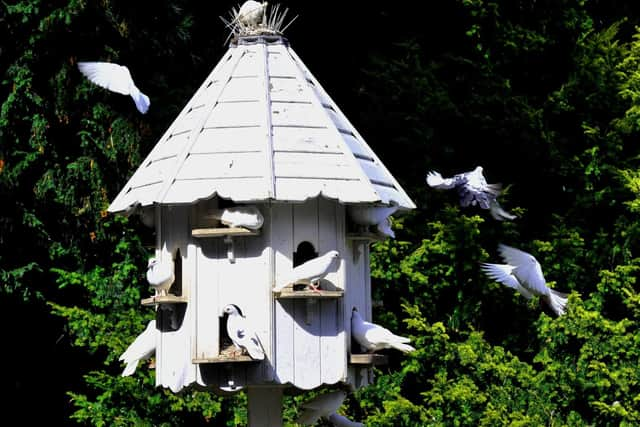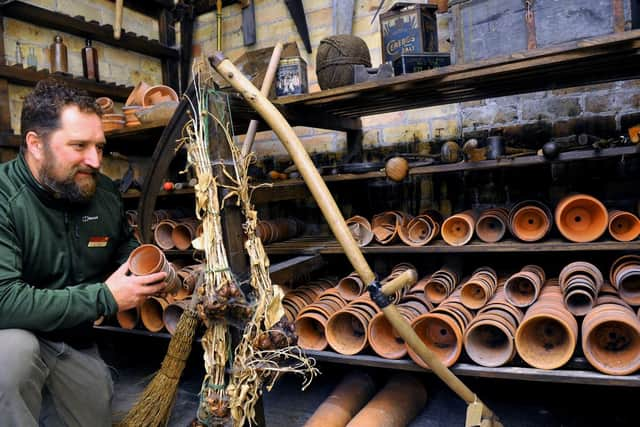Burnby Hall Gardens: The Yorkshire gardens that have been restored to Edwardian splendour


The gardens - once part of the grounds of Burnby Hall, near Pocklington - are nearing the end of a three-year restoration programme funded by a £640,000 Heritage Lottery grant.
Staff have dredged the 105-year-old Upper Lake, restored the rock garden, re-planted the nationally-significant water lily collection and brought the derelict potting shed and summerhouse back into use.
Advertisement
Hide AdAdvertisement
Hide Ad

The result is a fine example of Edwardian horticulture that its team of gardeners expect will attract more visitors and play an increasing role in community life on the edge of the Yorkshire Wolds.
The site is open to the public as a result of an extraordinary act of generosity by its paternalistic former owner, Major Percy Marlborough Stewart, and his wife, who left their estate in trust to the people of Pocklington after the Major's death in 1962.
Gardens manager Ian Murphy joined Burnby Hall straight from Bishop Burton College in 1994, and found himself head gardener a year later. He has since overseen a remarkable transformation.
Advertisement
Hide AdAdvertisement
Hide Ad"We've now just about completed the restoration project. The lake is unique as it has a concrete bed and we de-silted and renovated it. The rock garden had become overgrown, so we stripped it bare, left it fallow for a year and re-planted it with the help of 30 volunteers.


"The water lily regeneration ended up 12 weeks behind schedule - next spring around 800 plants that have been contract-grown will be re-planted. The Edwardian potting shed and summerhouse, which were built in 1910, were in a poor state of repair and have been restored.
"The whole project has been ongoing for about six years, since the start of the application process for funding.
"When I first arrived, the gardens were good, but it was always difficult to find the money for capital works - we could only afford to maintain them. We got a grant to renovate the museum and tearoom in 2010 and decided we'd need further outside funding for the gardens. Heritage Lottery have been a great support."
Advertisement
Hide AdAdvertisement
Hide Ad

Ian believes the standard of horticulture on display has improved significantly since the 1960s, when the public were first able to visit Burnby Hall Gardens. Plans are now afoot to bring the hall itself back into use as a heritage centre - it's currently council offices, but it's hoped that it could eventually become the place where Pocklington's recent Iron Age archaeological finds are displayed so that they remain in the local area.
"Visitor numbers have increased since the restoration, and people are really interested in the work we've done and in the behind-the-scenes tours we run. There are more activities and events here now, as part of the conditions of the grant were that we did more outreach work in the community. We also have more volunteers who are helping with the gardens and with research into the Stewart Collection."
Visitors today can enjoy the two lakes, National Collection of water lilies, secret garden, tulips, aviary with exotic birds, Victorian garden with gazebo, rock garden, stumpery, potting shed with vintage tool exhibition and summerhouse. The gardens are home to kingfishers, herons, moorhens and giant ornamental fish which can be hand-fed. There's a shop and cafe, and the gardens can even be booked as a wedding venue.
"It's always been well-visited - we're actually the 18th most popular attraction in Yorkshire, but we're aiming to increase our horticultural value, make changes and introduce new things for people to see, while retaining the character," adds Ian.
Advertisement
Hide AdAdvertisement
Hide Ad

Burnby Hall Gardens are open until November 3 from 10am-5.30pm. Entry is £5.50 for adults and £3.10 for children.
Burnby Hall - a history
Percy Marlborough Stewart was born in 1871. Although he was a second cousin of Winston Churchill - thus his middle name - his family were not wealthy and his father was a clergyman. He had 13 siblings and was expected to find a profession. After studying Hebrew at Cambridge, he arrived in the East Riding to take up a teaching position at Pocklington School at the turn of the 20th century.
He became involved with the local hunt, and met a local vicar's widow, Katharine Priestman, the daughter of a Durham coal magnate. In 1901, they married and rented Ivy Hall, which they later bought and re-named Burnby Hall.
Advertisement
Hide AdAdvertisement
Hide AdThe couple were classic Edwardian adventurers who travelled the world and returned with curious objects to display in their new home, but they were also keen gardeners who made major alterations to their estate. Their foreign travels from 1906 until 1926 saw them visit the US, Canada, Africa, India, the Far East, New Zealand and the Pacific Islands. Percy was a passionate game hunter who brought back exotic stuffed specimens as trophies.


They sank the two lakes for fishing, and introduced hardy water lilies in 1935, beginning a collection that would eventually attain national importance.
During World War One, Percy held administrative roles as he was too old for overseas service, and was given the rank of Major. He was a Toad of Toad Hall-type eccentric figure who once crashed a steam-powered motor car on the hairpin bends of Sutton Bank in the North York Moors.
He was widowed in 1939 and remained at the hall until his death at the age of 90 in 1962. The couple had been childless and bequeathed the entire estate to the people of Pocklington.
Advertisement
Hide AdAdvertisement
Hide AdThe Stewarts Trust was set up to run the gardens and administer the Stewart Collection, which is housed in a purpose-built museum on the site and includes objects and treasures brought back from all over the world.
Burnby Hall is now used as council offices.
The gardens have been open to visitors for decades, but in 2016 the Trust secured a £640,000 Heritage Lottery Fund grant to undertake a major restoration project.
They de-silted the Upper Lake, repaired cracks, and regenerated the water lilies, which are planted in brick boxes on the concrete-lined lake bed - there are nearly 100 varieties and they now have National Collection status.